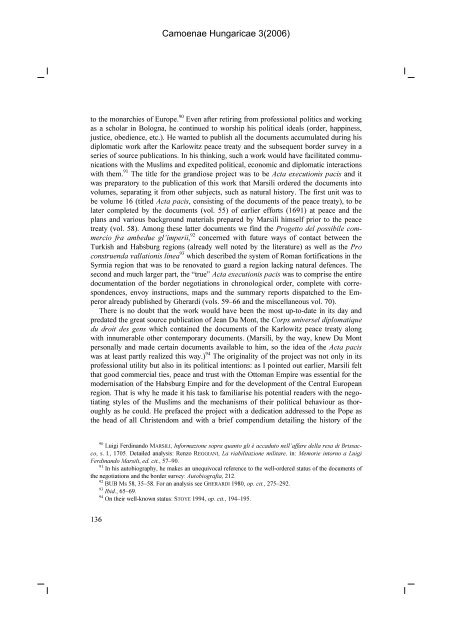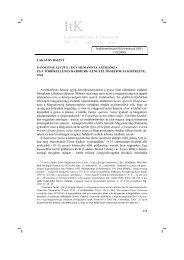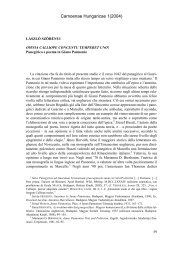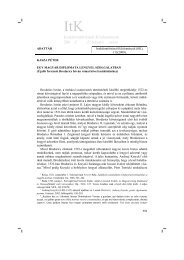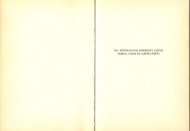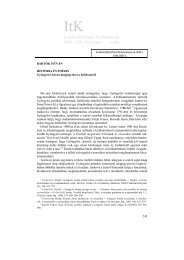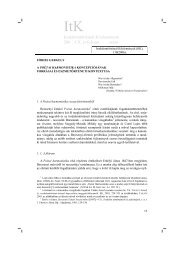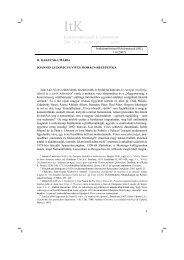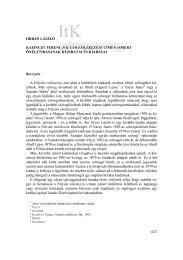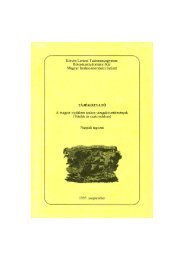Camoenae Hungaricae 3(2006) - Irodalomtörténeti Közlemények
Camoenae Hungaricae 3(2006) - Irodalomtörténeti Közlemények
Camoenae Hungaricae 3(2006) - Irodalomtörténeti Közlemények
Create successful ePaper yourself
Turn your PDF publications into a flip-book with our unique Google optimized e-Paper software.
to the monarchies of Europe. 90 Even after retiring from professional politics and working<br />
as a scholar in Bologna, he continued to worship his political ideals (order, happiness,<br />
justice, obedience, etc.). He wanted to publish all the documents accumulated during his<br />
diplomatic work after the Karlowitz peace treaty and the subsequent border survey in a<br />
series of source publications. In his thinking, such a work would have facilitated communications<br />
with the Muslims and expedited political, economic and diplomatic interactions<br />
with them. 91 The title for the grandiose project was to be Acta executionis pacis and it<br />
was preparatory to the publication of this work that Marsili ordered the documents into<br />
volumes, separating it from other subjects, such as natural history. The first unit was to<br />
be volume 16 (titled Acta pacis, consisting of the documents of the peace treaty), to be<br />
later completed by the documents (vol. 55) of earlier efforts (1691) at peace and the<br />
plans and various background materials prepared by Marsili himself prior to the peace<br />
treaty (vol. 58). Among these latter documents we find the Progetto del possibile commercio<br />
fra ambedue gl’imperii, 92 concerned with future ways of contact between the<br />
Turkish and Habsburg regions (already well noted by the literature) as well as the Pro<br />
construenda vallationis linea 93 which described the system of Roman fortifications in the<br />
Syrmia region that was to be renovated to guard a region lacking natural defences. The<br />
second and much larger part, the “true” Acta executionis pacis was to comprise the entire<br />
documentation of the border negotiations in chronological order, complete with correspondences,<br />
envoy instructions, maps and the summary reports dispatched to the Emperor<br />
already published by Gherardi (vols. 59–66 and the miscellaneous vol. 70).<br />
There is no doubt that the work would have been the most up-to-date in its day and<br />
predated the great source publication of Jean Du Mont, the Corps universel diplomatique<br />
du droit des gens which contained the documents of the Karlowitz peace treaty along<br />
with innumerable other contemporary documents. (Marsili, by the way, knew Du Mont<br />
personally and made certain documents available to him, so the idea of the Acta pacis<br />
was at least partly realized this way.) 94 The originality of the project was not only in its<br />
professional utility but also in its political intentions: as I pointed out earlier, Marsili felt<br />
that good commercial ties, peace and trust with the Ottoman Empire was essential for the<br />
modernisation of the Habsburg Empire and for the development of the Central European<br />
region. That is why he made it his task to familiarise his potential readers with the negotiating<br />
styles of the Muslims and the mechanisms of their political behaviour as thoroughly<br />
as he could. He prefaced the project with a dedication addressed to the Pope as<br />
the head of all Christendom and with a brief compendium detailing the history of the<br />
90<br />
Luigi Ferdinando MARSILI, Informazione sopra quanto gli è accaduto nell’affare della resa di Brissacco,<br />
s. l., 1705. Detailed analysis: Renzo REGGIANI, La riabilitazione militare, in: Memorie intorno a Luigi<br />
Ferdinando Marsili, ed. cit., 57–90.<br />
91<br />
In his autobiography, he makes an unequivocal reference to the well-ordered status of the documents of<br />
the negotiations and the border survey: Autobiografia, 212.<br />
92<br />
BUB Ms 58, 35–58. For an analysis see GHERARDI 1980, op. cit., 275–292.<br />
93<br />
Ibid., 65–69.<br />
94<br />
On their well-known status: STOYE 1994, op. cit., 194–195.<br />
136<br />
<strong>Camoenae</strong> <strong>Hungaricae</strong> 3(<strong>2006</strong>)


